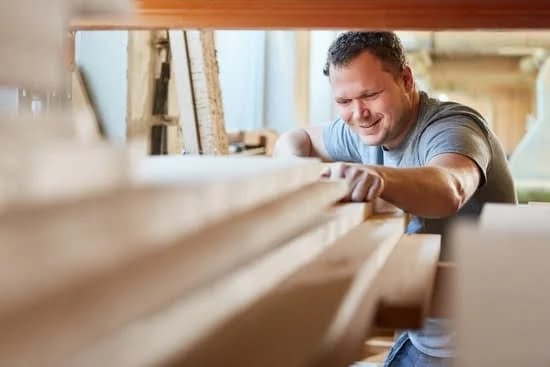Are you looking for ways on how to make rounded corners woodworking? Rounded corners can add a touch of elegance and sophistication to your woodworking projects. Whether you are working on furniture, cabinets, or other wood items, knowing how to create rounded corners can take your craftsmanship to the next level.
In this article, we will explore the techniques and tips for achieving perfectly rounded corners in woodworking. From selecting the right materials to using the appropriate tools, we will guide you through each step of the process. Whether you are a beginner or an experienced woodworker, this comprehensive guide will help you enhance your skills and bring your woodworking projects to life.
Creating rounded corners involves a combination of precise measurements, proper cutting techniques, and meticulous finishing. With the right knowledge and tools at your disposal, you can achieve professional-looking rounded corners that will elevate the visual appeal of your woodworking projects. So, let’s dive in and discover how to master the art of making rounded corners in woodworking.
Tools and Materials Needed for Creating Rounded Corners
When it comes to creating rounded corners in woodworking, having the right tools and materials is essential for achieving a professional finish. Here are some of the key items you will need to get started on your rounded corner woodworking project.
Tools
One of the most important tools for creating rounded corners is a router, which allows you to cut and shape the wood with precision. You may also want to invest in a set of router bits specifically designed for creating rounded edges. Other useful tools include a jigsaw for rough cutting the corners before shaping, as well as a sanding block or orbital sander for smoothing out any rough edges.
Materials
The type of wood you choose for your project can have a significant impact on the final look of your rounded corners. Hardwoods such as oak, maple, or cherry are popular choices for their durability and beautiful grain patterns.
Softwoods like pine or cedar are also suitable for rounded corners, especially if you want to achieve a more rustic or natural look. In addition to the wood itself, you’ll need sandpaper of various grits for sanding and finishing your rounded corners to perfection.
Safety Gear
Lastly, don’t forget about safety gear when working with power tools and machinery. Safety goggles, ear protection, and a dust mask are all essential items to protect yourself while creating rounded corners in woodworking.
By ensuring that you have all the necessary tools, materials, and safety equipment at your disposal, you can set yourself up for success when tackling rounded corners in woodworking projects.
Choosing the Right Wood for Rounded Corners
When it comes to creating rounded corners in woodworking, it is important to choose the right type of wood for your project. Certain woods are better suited for shaping and smoothing rounded corners due to their grain and density.
One popular choice for creating rounded corners is hardwood, such as oak, maple, or cherry. Hardwoods are durable and can hold up well against the cutting and shaping process required to achieve rounded edges. They also provide a beautiful finish when sanded and sealed properly.
Another option for creating rounded corners is using softwood, such as pine or cedar. Softwoods are easier to work with and can be more forgiving when cutting and shaping. However, they may not hold up as well over time compared to hardwoods.
It is also important to consider the grain of the wood when choosing materials for creating rounded corners. Woods with a straight grain, such as maple or cherry, are ideal for achieving clean and smooth curves. On the other hand, woods with interlocking or irregular grain patterns may pose challenges when shaping rounded edges.
In summary, choosing the right wood for creating rounded corners in woodworking can greatly impact the overall outcome of your project. Consider factors such as hardness, grain pattern, and durability when selecting materials for achieving professional-looking curved edges.
| Wood Type | Ideal For |
|---|---|
| Hardwood (oak, maple, cherry) | Durable, beautiful finish |
| Softwood (pine, cedar) | Easier to work with |
Step-by-Step Guide on How to Measure and Mark the Rounded Corners
When it comes to creating rounded corners in your woodworking projects, one of the most important steps is to accurately measure and mark the corners before cutting and shaping. This ensures that your rounded corners will be uniform and aesthetically pleasing. In this step-by-step guide, we will walk you through the process of measuring and marking rounded corners for your woodworking projects.
The first step in creating rounded corners is to decide on the radius of the curve you want to achieve. This will depend on the specific design of your project and personal preference. Once you have determined the radius, gather a compass, pencil, and ruler for precise measurements. Use the compass to draw an arc with the desired radius on each corner of the wood. This will serve as a guide for cutting and shaping the rounded corners.
Next, it’s essential to double-check your measurements and ensure that all four corners are marked consistently. Use a square or ruler to confirm that the distance from each corner to the marked arc is uniform. This will guarantee symmetrical rounded corners across your woodworking project. Additionally, make sure that the arcs are evenly spaced from the edge of the wood for a balanced look.
After marking all four corners with precision, take a moment to review each marking before proceeding with cutting and shaping. Accuracy in this initial stage is crucial for achieving professional-looking rounded corners in woodworking projects.
By following these step-by-step instructions on how to measure and mark rounded corners, you can ensure that your woodworking projects have a polished finish with smooth curves. Whether you’re creating furniture, decorative pieces, or other wooden items, mastering this process is essential for achieving professional results in woodworking.
Incorporating beautifully crafted curved edges can elevate your woodworking projects by adding an elegant touch. With attention to detail and precision in measuring and marking rounded corners, your creations will stand out for their refined craftsmanship.
Techniques for Cutting and Shaping Rounded Corners
When it comes to woodworking, creating rounded corners can add a touch of elegance and softness to your projects. To achieve this, you will need the right techniques for cutting and shaping the wood. There are several methods you can use to achieve rounded corners, depending on the tools you have and the specific look you want to achieve.
To get started with cutting and shaping rounded corners in woodworking, you will need the following tools and materials:
- Jigsaw or coping saw
- Router with a round-over bit
- Sandpaper in various grits
- Wood clamps
- Pencil for marking
- Safety goggles and dust mask
Here’s a step-by-step guide on how to cut and shape rounded corners:
- Measure and mark the area where you want the rounded corner to be. Use a pencil and a ruler to make precise markings.
- Secure the wood using clamps to ensure stability while cutting.
- If using a jigsaw, carefully follow the marked line to cut away the excess wood. Take your time and use steady hands for an even cut.
- If using a router with a round-over bit, set it up according to the desired radius for your rounded corner. Then, slowly run the router along the edge of the wood, moving in the direction of the grain.
- After cutting, use sandpaper in various grits to smooth out any rough edges and refine the shape of your rounded corner.
These techniques will help you achieve professional-looking rounded corners in your woodworking projects. Remember to always prioritize safety when using power tools and keep practicing to perfect your skills.
Sanding and Finishing the Rounded Corners for a Professional Look
Once you have cut and shaped your wood to create rounded corners, the next step is sanding and finishing. Sanding is crucial for achieving a smooth surface and removing any rough edges left from cutting.
It’s important to start with a coarse grit sandpaper and gradually work your way to a finer grit for a polished finish. When sanding rounded corners, it’s best to use a flexible sanding block or sponge to ensure that you can easily reach all areas of the curve.
After sanding, it’s time to apply a finish to the wood. This not only protects the wood from damage, but it also enhances its natural beauty. A popular choice for finishing rounded corners is using a clear varnish or polyurethane, which provides a glossy protective layer. Alternatively, if you prefer a more natural look, you can use wood oil which penetrates the wood to bring out its natural color and grain.
To achieve professional-looking rounded corners in woodworking, take your time with both sanding and finishing. Rushing through these final steps can result in an uneven surface or an unpolished appearance that detracts from the overall quality of your project. With patience and attention to detail, you can achieve perfectly smooth and beautifully finished rounded corners that add a touch of elegance to your woodworking creations.
| Woodworking Tip | Description |
|---|---|
| Use Flexible Sanding Block | This tool will help you easily reach all areas of the curve when sanding rounded corners. |
| Apply Clear Varnish or Polyurethane | To protect and enhance the wood, consider using one of these finishes for rounded corners. |
| Take Your Time | Rushing through sanding and finishing can result in an unpolished appearance – be patient for professional results. |
Troubleshooting Common Issues When Creating Rounded Corners
Uneven Cuts
One common issue when creating rounded corners in woodworking is ending up with uneven cuts. This can happen if the cutting tool is not held steadily or if the measurement and marking process was not accurate. To troubleshoot this issue, it’s important to ensure that the cutting tool is held firmly and consistently throughout the entire cutting process. Using a guide or template can also help maintain uniformity in the cuts.
Tearing and Splintering
Another issue that woodworkers may encounter when creating rounded corners is tearing and splintering of the wood. This can occur during the cutting and shaping process, especially if using a high-speed cutting tool or if working with a type of wood that is prone to splintering.
To troubleshoot this problem, it’s advisable to use a sharp cutting tool and to work at a slower pace when shaping the rounded corners. Additionally, using masking tape along the cutting line can help minimize tearing and splintering.
Imperfect Finishing
After shaping and cutting rounded corners, achieving a smooth and professional-looking finish is crucial. However, imperfections in finishing such as rough edges or uneven surfaces can be common issues.
To troubleshoot this problem, it’s important to carefully sand down any rough edges using fine-grit sandpaper until they are smooth and even. Additionally, applying multiple coats of finish and allowing each coat to dry thoroughly before applying the next can help achieve a flawless look for rounded corners in woodworking projects.
Inspiration and Ideas for Incorporating Rounded Corners Into Woodworking Projects
When it comes to incorporating rounded corners into woodworking projects, there are endless possibilities for adding a touch of style and elegance to your creations. Whether you’re working on a simple picture frame or a more complex piece of furniture, rounded corners can add a modern and sleek look. Here are some inspiration and ideas for incorporating rounded corners into your woodworking projects:
- Picture frames: Instead of the traditional square or rectangular shape, consider adding rounded corners to your picture frames for a softer and more sophisticated look.
- Tabletops: Adding rounded corners to tabletops can create a more inviting and comfortable feel. It also reduces the risk of accidental bumps and bruises on sharp edges.
- Cabinetry: Rounded corners on cabinet doors and drawers can give your kitchen or bathroom a more contemporary and streamlined appearance.
- Decorative boxes: Whether it’s for jewelry, trinkets, or keepsakes, incorporating rounded corners into decorative boxes can give them a more polished and professional look.
While these are just a few examples, the possibilities for using rounded corners in woodworking projects are truly limitless.
Incorporating rounded corners into your woodworking projects can be an excellent way to showcase your skills while adding an interesting design element. By utilizing different techniques for cutting and shaping rounded corners, you can create unique and visually appealing pieces that stand out. Additionally, experimenting with different wood types and finishes can also significantly impact the overall aesthetic of your project.
Ultimately, whether you’re going for a modern, minimalist look or aiming for something more classic and timeless, incorporating rounded corners into your woodworking projects is sure to elevate the final result. With attention to detail and creativity, you can seamlessly integrate rounded corners into almost any woodworking project.
Conclusion
In conclusion, mastering the art of creating rounded corners in woodworking takes practice, patience, and attention to detail. By following the step-by-step guide and using the right tools and materials, anyone can successfully achieve professional-looking rounded corners on their woodworking projects.
One important tip for perfecting rounded corners is to take the time to choose the right type of wood for your project. Different woods have different characteristics that can affect the outcome of your rounded corners. Additionally, paying close attention to measuring and marking before cutting and shaping will ensure precision in the final result.
Another crucial aspect to consider is the technique used for cutting and shaping rounded corners. Whether using a router, sanding tool, or hand plane, it’s essential to practice these techniques on scrap pieces of wood before applying them to your actual project. This will help you become more comfortable with the process and avoid common issues such as tear-out or uneven curves.
Lastly, don’t be afraid to seek inspiration from other woodworking projects that incorporate rounded corners. By studying different designs and techniques used by experienced woodworkers, you can gain valuable insights on how to enhance your own skills in creating rounded corners. With dedication and persistence, anyone can become proficient in this aspect of woodworking.
Frequently Asked Questions
How Does Lumber Get Rounded Edges?
Lumber gets rounded edges through a process called edge profiling, which involves using a router or shaper to shape the edges of the wood. This can be done with different router bits or cutting blades to achieve different rounded profiles, such as bullnose, quarter-round, or beveled edges.
The process helps to create a smoother and more finished look for the lumber.
How Do You Cut Rounded Corners?
To cut rounded corners, one can use various tools depending on the material being cut. For wood, a hand-held jigsaw or band saw with a rounded blade can be used to carefully cut along the desired curve.
For metal or plastic, a rotary tool like a Dremel with a cutting wheel attachment can be used to achieve the same effect. It’s important to measure and mark the cutting line accurately before making any cuts.
How Do You Round the Edge of a Plank?
Rounding the edge of a plank can be accomplished using tools like a router or sandpaper. If using a router, different bits can be used to create different rounded profiles on the edge of the plank.
Alternatively, using sandpaper or a hand plane can help gradually round off the sharp edges of the plank by smoothing them down manually. This process not only adds visual appeal but also helps prevent splintering and makes handling the plank safer.

Hi everyone! I’m a woodworker and blogger, and this is my woodworking blog. In my blog, I share tips and tricks for woodworkers of all skill levels, as well as project ideas that you can try yourself.





